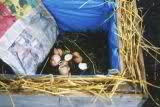 Deep beneath the earth, they thrive — pink, slimy and insatiably hungry. They’re with us all the time, rooting through our gardens, digging through our lawns and consuming everything in their path. Aristotle called them the intestines of the world. The ancient Chinese called them angels of the soil. Angels or intestines, worms are a tiny but formidable force, eating their way through organic matter and leaving a trail of rich humus in their wake. Vermicomposting is the practice of using worms to turn your organic waste into nutrient-rich fertilizer.
Deep beneath the earth, they thrive — pink, slimy and insatiably hungry. They’re with us all the time, rooting through our gardens, digging through our lawns and consuming everything in their path. Aristotle called them the intestines of the world. The ancient Chinese called them angels of the soil. Angels or intestines, worms are a tiny but formidable force, eating their way through organic matter and leaving a trail of rich humus in their wake. Vermicomposting is the practice of using worms to turn your organic waste into nutrient-rich fertilizer.
Why use worms? Well, for one, because they’re cool. Not only are they slimy and neat-looking, these amazing little organisms can eat up to half their body weight in food every day. Using worms instead of a compost pile ensures faster composting and a rich, dark fertilizer. Besides — what’s more fun than getting to say, “Worms eat my garbage?”
Building a Worm Compost Bin
Worm composting begins with a proper bin. You can build your own or invest in ultra-deluxe, multi-tiered, screened-in, self-sifting ventilation systems for hundreds of dollars. Another option is to find a plastic tub and poke holes in it. Like many activities, worm composting is limited only by your imagination. For temperature and moisture levels, however, a wooden bin is best. There are only a few requirements for a good worm bin:
* More surface area than depth (wide and shallow)
* Air holes in the bottom
* Low sides for ventilation
If kept properly, your worms will not crawl out of the bin. Worms are a non-migratory species, which means that they won’t go anywhere if they don’t have to. They’re also afraid of light. If you open your bin during the day, any worms at the top will dive down below the surface. They have no reason to leave if there’s food and comfortable bedding. If you are truly afraid of your worms escaping, you can build in a layer of mesh wiring around the air holes. Even if you’re not afraid of your red wigglers wiggling away, keep a lid with air holes on the bin and a layer of black plastic over the bedding (also with air holes cut in it) to keep light and other animals out.
The next thing you need is bedding. Shredded paper and leaves work well. This means that you can compost your office paper as well as your kitchen waste. Bedding needs to be lightly moist, but not dripping wet. Worms breathe through their skin, so having the right level of dampness and air flow is the key. But beware — if it gets too wet in the bin, the worms can drown. The best way to wet the bedding is to fill a separate bucket with water. Then dunk your bedding, by the handful, in the water and then squeeze it out until it’s barely dripping. Next, pull the bedding apart before putting it in the bin to create air pockets and passageways for the worms. Finally, throw in a couple of handfuls of dirt and leaves from your back yard to give them some grit and good bacteria. Worms are similar to birds in their digestion: They have gizzards that require grit to aid in grinding up their food. Soil and other gritty organic waste, such as coffee grounds, can help with this process.
Where should you keep your bin? Anywhere that’s safe from other animals and extreme temperatures. This can be a basement, patio or even your kitchen. If you bury the food below the bedding properly, the only smell coming from the bin should be that of fresh, damp earth. If your vermicomposting system is healthy, the decomposing food will not smell or attract flies. Remember, worms can freeze or even burn, so your worm bin should be kept in temperatures ranging from 40 to 90 degrees Fahrenheit (4.4 to 32.2 degrees Celsius). If it gets colder or hotter, try to bring them inside.
Once you’ve found a good location and you have your worm bin and bedding all set up, it’s time to dump in the worms. They’ll need a day or two to adjust to the new space before you begin to feed them.
Worm Compost Food and Established Bins
Now comes the fun part of having a worm bin — feeding the little guys. You can bury just about anything that originally came out of the ground in the bin. Coffee grounds and filters, tea leaves and bags, fruit and veggie peels and cores, paper, rice, grits, and natural fabrics are all things that can go in the bin. Eggshells that have been washed out and ground up are also an excellent source of calcium for the worms.
The following items make good worm food:
* Leafy greens
* Potatoes
* Non-acidic fruits and vegetables (tomatoes, green peppers)
* Low-acidity citrus
* Coffee & tea grounds
* Rice
* Grits
* Paper
* Cotton
* Eggshells
There are also several items that will harm the worms. For one, don’t feed them anything fatty or oily. Worms can’t digest meat proteins or lactose, so no dairy products either, like milk or cheese. While worms do like egg shells, the egg cannot go in the bin. Citrus and salt can actually harm the skin of the worms. We mentioned earlier that worms breathe through their skin, so just imagine if your lungs were on the outside of your body and someone decided to rub salt and lemon on them — you probably wouldn’t appreciate it either.
These items will harm your worms. Never give them:
* Butter
* Oil
* Salad containing salad dressing
* Eggs
* Meat
* Highly acidic fruits and vegetables (lemons, limes, oranges)
* Hot peppers
* Salt
* Animal waste
* Plastic
* Synthetic materials
* Insecticides
Once you’ve had your worms for a while, you’ll get a feel for what they like to eat and what they don’t. You’ll also know how much to feed them and when. If your bin starts to smell bad, you’re either feeding them so much that they can’t keep up, or you’re not burying the food well enough under the bedding.
Established bins that are healthy begin to reproduce worms and attract other decomposers. If you see other insects crawling around in there, don’t be worried. It’s OK unless there are a lot of flies hanging around. If you have a lid on your worm bin and bury your food well, you should not have to worry about flies or maggots. These other insects are helping the process, making sure that you can compost even more of your organic waste. After a while, you may also see tiny white sacks that may appear to be maggots. These are actually worm egg sacks — or possibly even baby worms.
Your worm population should double in size every three months or so. When this happens, you can build new worm bins and transfer some worms over if they get to be too much for one area. If you feel that you can’t keep up with the feeding schedule, you have a few different options. Teach your neighbors how to compost and donate some worms to them.
Source: Pocock, Jennifer. “How Vermicomposting Works.” 30 June 2008. HowStuffWorks.com. <http://home.howstuffworks.com/vermicomposting.htm> 29 August 2009.
Do you like this Money making business ideas? then please consider subscribing to our RSS feed and have new business ideas sent directly to your inbox. (Once you entered your e-mail address, you need to login to your e-mail account and click the link to confirm your subscription).




Paano kung may langam na pula sa bins, hindi ba ito makakasama sa worms?
maganda dito sa pinoy bisnes.com.
Pwede ka magtanong sa DA-ATI office or kay Dr. Ne Velasco ng Sultan Kudarat State University, Tacurong City.. meron din sa USM, Kabacan.
🙂
tga gen san po ako saan po ako makakabili ng worm for compost.